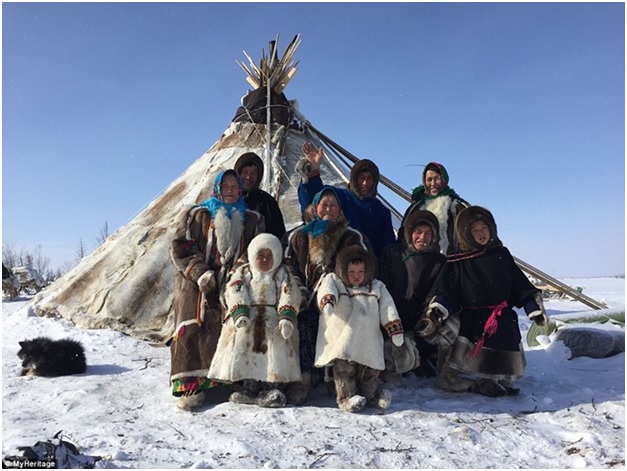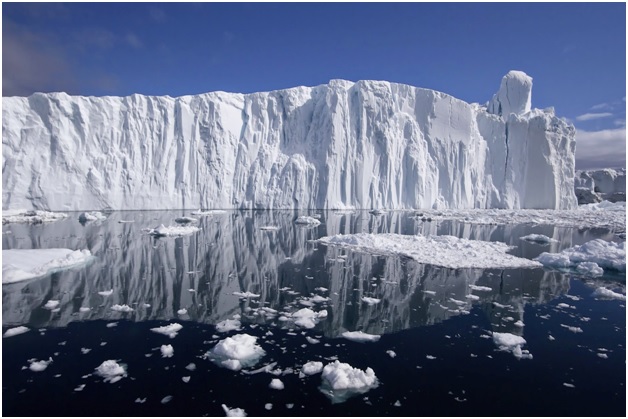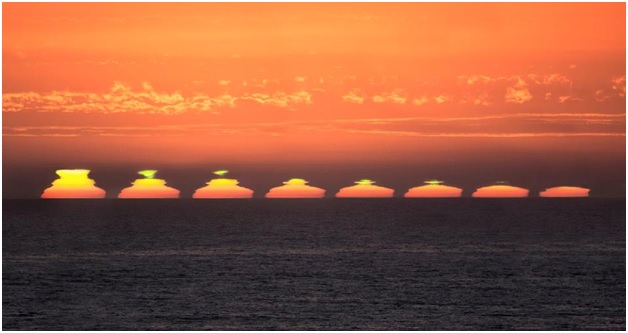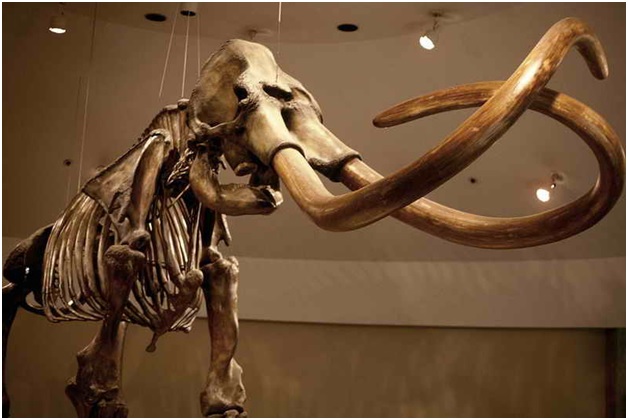
The Arctic is the most unusual region on our planet and it is not surprising that it is called enigmatic and mysterious, because this region is hiding many miracles.
The Arctic has a unique nature - the giant expanses of ice and snow, huge icebergs of the most incredible and bizarre forms, drifting in the arctic seas. This is a land, where polar bears and reindeers live, rare animals and birds inhabit, the Arctic seas are full of valuable species of fish, and in the bowels of the Arctic lie the richest reserves of natural resources. This is the only place on earth where there are large accumulations of mammoth bone, which has been preserved in the permafrost for several millennia. Such finds, especially mammoth tusks, are valuable fossil remains of mammoth fauna.
The Arctic is really a special land. It is a peculiar region, unlike any other inhabited by people. There are several poles, there are no days and nights in the usual sense, in this region the polar day and polar night last six months each.
The real miracle of the Arctic is the Northern Lights (or Aurora Borealis), which can last for several days, coloring the sky in various iridescent tones. On this northern land there are other amazing natural phenomena. For example, here you can see the “icy sky” and find “ice flowers”, and each phenomenon is unusual and unique. Probably, that's why they say that the Arctic attracts and leaves indelible impressions for life.
History of the Arctic. Mankind tried to conquer the North Pole many times, but it was not easy and cost many lives. In 1827 the British Rear Admiral Sir William Edward Parry managed to get from Svalbard to 82°45'N. Expeditions of the Americans Charles Francis Hall (1871) and George W. De Long (1881) were ill-fated, both researchers died.
In 1908 the American Frederick Cook claimed that he, for the first time in the history of mankind, reached the geographical North Pole. In 1909, it was disputed by fellow countryman Robert Peary, who allegedly visited the North Pole on April 6, 1909. At present, the priority of both polar explorers is questioned. But there is no doubt that on May 12, 1926, Norwegian Roald Amundsen with a team of 15 people on an airship “Norge” flew over the North Pole. In 1937, the flag of the USSR was raised above the North Pole and the world’s first station at the pole North Pole-1 under the leadership of Ivan Papanin was officially established. However, the landing directly on the pole was carried out by another Soviet expedition only in 1948. At the same time, the depth at the North Pole point (4039 m) was measured for the first time. In 1958 the first submarine (the US nuclear submarine USS Nautilus) to complete a submerged transit under the North Pole. In 1962, the nuclear submarine Lenin Komsomol (USSR) reached the pole. In 1977, a nuclear icebreaker Arktika (USSR) was the first surface ship to reach the North Pole.
The Arctic is the northern polar region of the Earth, including the Arctic Ocean and its seas, as well as the numerous straits and gulfs of the Canadian Arctic Archipelago, the northern parts of the Pacific and Atlantic Oceans, the Canadian Arctic Archipelago, Greenland, Spitsbergen, Franz Josef Land, Novaya Zemlya, Severnaya Zemlya, the Novosibirsk Islands and Wrangel Island, as well as the northern coasts of the continents of Eurasia and North America. The boundary of the Arctic is set both along the Arctic Circle (66 °33’N), and along the southern boundary of the tundra zone. The total area of the Arctic changes depending on criteria used. If we limit the Arctic by the Arctic Circle, its area will be 21 million sq. km (8.1 million sq. miles), if by the southern border of the tundra - 26.4 million sq. km (10.2 million sq.miles). The permafrost is widespread in the Arctic almost everywhere.
In the XI century Russian navigators went to the seas of the Arctic Ocean. In the XII-XIII centuries they discovered the islands of Vaygach, Novaya Zemlya, and at the end of the XV century – the islands of the Spitsbergen archipelago and Bear Island. Wintering of Russian Pomors is still being investigated by archaeologists. It is interesting that excavations on the island of Spitsbergen gave unique finds that the Pomors wintered in the harsh conditions of the Far North with their families, even with young children. Historians have discovered the remains of the alphabet, children's things and chess pieces, that is, the Pomors have spent the polar night playing chess.
Indigenous peoples of Russian Arctic. The first inhabitants who came to this land more than 30’000 years ago, are still living here. According to statistics, indigenous peoples of the Russian Arctic are represented by 17 different ethnic groups. These social groups differ from each other by native language, traditions, attachments, cultural and sociological institutions and values. As a rule, indigenous peoples of the Arctic are few in number, rarely exceeding 50’000 people.

The list of the indigenous peoples of Russian Arctic was regulated by the state, it includes Vepsians, Aleuts, Nenets, Kets, Alyutors, Eskimos, Saami, Oroks, Dolgans, Enets, Ulchs, Chukchi, Kamchadals, Evens, Evenks, Yakuts, Nganasans, etc. Indigenous peoples of the Arctic are relatively small in number, according to the latest census, they total some 260’000 people.
Arctic Poles. There are four poles in the Arctic: the Geographic North Pole, the North Magnetic Pole, the Pole of Cold and the Pole of Inaccessibility. These points in the Northern Hemisphere are widely scattered and do not coincide with the Geographical North Pole, where Earth’s axis of rotation meets the surface.
Geographic North Pole is located in the central part of the Arctic Ocean and is a special point of our planet, where the meridians and all time zones converge, so the time is not specified here. And usually polar expeditions are guided by the time, accepted at their respective countries.
The North Magnetic Pole is a conventional point of the earth's surface in which the earth's magnetic field is directed to the surface at right angles. The position of the magnetic pole is unstable and its coordinates are temporary and inaccurate, as it moves daily along an elliptical trajectory and shifts in the north and north-west directions. From the second half of the twentieth century, the magnetic pole is moving toward Taimyr Peninsula, in “quiet” periods at a speed of a kilometer per year, and in periods of geomagnetic activity up to tens of kilometers per year.
There is a place on the Earth, that is colder than the North Pole. On meteorological maps it is referred to as the Pole of Cold of the northern hemisphere. It is located in the Yakut village of Oymyakon, located in Eastern Siberia. It has a population of 521. Quite a large distance of Oymyakon from the ocean and its location in high latitudes form a sharply continental climate here. In winter, the thermometer in these places drops below minus 50°C…minus 60°C (minus 60°F…minus 75°F). The absolute minimum in Oymyakon was recorded in February 1933 (minus 67.7°C, i.e. minus 89.9°F). This is the coldest permanently inhabited place on the planet.
The Pole of Inaccessibility is the place on ice mass with area of some 3 million sq. km (1.16 million sq. miles), with maximum distances from all the shores of the Arctic Ocean and is located at the greatest distance from any land. It is located 170 degrees East, about 600 km from the North Pole. Due to the remoteness of this point from convenient transport routes, the Pole of Inaccessibility is considered difficult to reach. But in spite of this, in 1941 Soviet polar explorers made the first expedition to this pole on “USSR-N-169” airplane led by I.Cherevichny. In 1986, the expedition led by Dmitry Shparo reached the Pole of Inaccessibility on foot during the polar night period.
Aurora. One of the most striking and amazing phenomena of nature is the Aurora or Polar Lights that light the sky in the form of arches, arcs, swaying curtains of various colors. A fascinating sight, which Arkhangelsk Pomors have long been called “spolokhs”, can last from an hour to several days. This luminescent glow occurs from the collision of charged particles from the Sun with molecules and atoms of gases in upper, thin part of Earth's atmosphere.

The most common forms of aurora are arches and arcs, which are usually formed at an altitude of 60 to 100 kilometers. Glow in the form of swaying curtains occurs at an altitude of 110-120 kilometers, and red lights are formed at the highest altitudes - 900-1000 kilometers. A little lower their color becomes purple, and in the layers closest to the Earth, green rays and flashes form.
Sometimes auroras reach such a colossal power that they cover huge expanses of the sky. In 1872 aurora embraced almost the entire northern hemisphere, and in 1938 it could be observed throughout the European part of Russia.
However, this impressive spectacle also has a negative side that affects the human activity. Intense auroras cause powerful electromagnetic interference, disrupting the normal operation of radio and compasses. True, usually these phenomena occur in winter, when the work of geologists, polar explorers, pilots and other specialists are minimized. In any case, experienced polar explorers know that during a powerful aurora, one should not work with equipment and travel.
Polar day and polar night. A polar day and a polar night are also the wonders of the Arctic. Back in the 5th century BC, their existence was predicted by the ancient Greek mathematician and astronomer Bion of Abdera, who was the first who said that there should be places on the Earth in which the night lasts for 6 months and the day lasts for 6 months.
A polar day is a period when the Sun does not go beyond the horizon longer than one day. During the polar day, the sun can not fall over the horizon for many days, and circle along the horizon line. At the North Pole it lasts from spring to autumn equinox - from 64 to 186 days. Its duration increases to the north of the Arctic Circle.
A polar night occurs in the Arctic in winter, when the Sun stays below a horizon more than one day. On the polar circles of the Earth, it lasts one day, the duration of the polar night increases to the north of the northern polar circle. At the North Pole, it lasts from autumn to spring equinox - 176 days. In Russia, a polar day and a polar night can be observed in Murmansk, Vorkuta, Norilsk, Severomorsk, Apatity and Tiksi.

The largest iceberg in the Arctic. The largest iceberg in the Arctic with an area of about 260 sq. km (100 sq. miles) and a thickness of 50 meters (165 feet) was recorded in 2010. It broke away from the Peterman Glacier in the northwest Greenland. The size of a huge ice block was 4 times larger than the island of Manhattan. There were no such large icebergs in the Arctic since 1962, and without exaggeration, he justified his name, since in the word “iceberg” means “ice mountain”. However, the emergence of this giant iceberg was not unexpected for specialists, since the first half of 2010 had the warmest global temperature on average for the whole history of observations, and a year before the iceberg cracks appeared in the Peterman glacier. In fact, icebergs from the Greenland glaciers are torn off by thousands, but such giants are really rare.
Amazing natural phenomena
“Icy Sky”. There are a lot of amazing natural phenomena in the Arctic. In particular, one can observe here the so-called “icy sky” effect, which is created as a result of the reflection of light by clouds, coming from the ice cover or floating ice in the polar waters. According to the reflection of the “icy sky”, which indicates the close location of the ice, you can navigate in the ocean to choose a path free from ice and icebergs. Especially clear reflection achieved, when the air is transparent and the ice is covered with snow.
Ice flowers. Another incredibly beautiful Arctic phenomenon is ice flowers. These creations of nature are nothing but small crystal bushes, not more than 3-4 centimeters (1-1.5 inch) high. Scientists have established that the emergence and growth of ice flowers is possible only on a thin, fresh layer of ice and in the presence of a large temperature difference between the surface of ice and air - not less than 20°C (36°F). But, unfortunately, the ice flowers are short-lived. As soon as the thickness of the ice increases, its temperature begins to approach the temperature of the air, and the flowers simply disappear.

“Icy rain”. There is an amazing kind of precipitation in the Arctic – “icy rain”. Every single rain drop is not frozen completely, but shelled with ice. When drops hit hard objects, they break up and leave ice shells on the surface.
The phenomenon of abnormal refraction. In the Arctic seas, the phenomenon of abnormal refraction can be observed. This is the refraction of light in the atmosphere, which arises from the difference in temperatures of the lower layers of air and water. It creates a lot of disturbances in the Arctic, since the objects and landscapes observed on the horizon are distorted due to the fact that the beam of vision, when passing through media with different density, is refracted in the horizontal and vertical directions. When a phenomenon of abnormal refraction occurs, the visible horizon either descends or ascends. Usually this phenomenon is preceded by the formation in the atmosphere of light haze and the wave-like trembling of the horizon. Researchers in the Arctic are well acquainted with this phenomenon, and some of them had to come across this visual “deception”.

Danish polar explorers, Unter and Poulsen once saw a musk ox, which they were going to hunt. But when they approached, it turned out that this was one of their dogs, which they considered a large animal because of the phenomenon of abnormal refraction. This phenomenon was also observed by crew of the ”Fram” ship led by the famous Norwegian explorer Fridtjof Nansen, when the crew mistook a piece of a wooden scoop for the land, the dimensions of which were increased hundreds of times. Notes of polar explorers mention that due to the phenomenon of abnormal refraction, sometimes several false suns appear on the horizon, and it is very difficult to understand which of them is real.
“Dead water”. Also there is an amazing phenomenon called “dead water”. A “dead water” phenomenon occurs in the Arctic seas, when a vessel in this zone suddenly starts to lose speed or even stops. For the first time, Norwegian polar researcher Fridtjof Nansen, who made a voyage in the Barents Sea in 1893, encountered such a phenomenon. The “dead water” phenomenon occurs in places where internal waves appear on the boundary of water layers with different densities. In this case, the surface layer of water has a much lower density than the lower water layer. In such a situation, the entire rotational energy of the ship's propellers only results in formation and maintenance of internal waves, instead of pushing the ship forward. As a result, the ship loses speed.
Mammoth Bone

Significant accumulations of mammoth bone are found only in the Russian Arctic - in the north of Siberia, the Far North and Chukotka. Over the past millennia, the mammoth bones have no changes in composition and properties, but almost do not differ from modern ivory. The most valuable is the mammoth tusk, which has an elegant texture in the form of a miniature mesh, as well as beautiful shades of yellow and pinkish tones. From the homogeneous bone tissue of the mammoth tusk carvers create unique carvings.
In the last century, the export of tusks from North-Eastern Siberia was 32 tons per year, this is approximately 220 pairs of tusks. Nowadays, the mammoth bone also is also in a high demand, both on the domestic and foreign markets. Depending on the quality of raw materials, prices range from $30 to $300 per kilogram. Thus, one large tusk of the highest quality can cost $15-20 thousand.
Today, largest Arctic tusk supplying regions are Western Siberia, the North Siberian lowland and the Central Taimyr. Quite a lot of mammoth tusks are found here, but, of course, these stocks are running low.
Potential tusk suppliers are Khanty-Mansi and Yamal-Nenets Autonomous Okrugs, Tyumen Oblast, Taimyr Autonomous Okrug, Sakha Republic (Yakutia), Magadan Oblast and Chukotka Autonomous Okrug.
Mineral Resources. According to the most approximate forecasts, more than 30% of the world's natural gas reserves and about 13% of oil reserves are concentrated here. The Arctic rich lands are claimed by countries of northern Europe, the USA, Canada and Russia.
To date, only 10% of the Russian shelf is developed, but even their reserves are abundant.
The Barents Sea: 11 oil and gas fields. One of them - the Shtokman field is one of the uniques (4,000 billion cubic meters of gas.). 7 more are considered large, 2 - medium and 1 small.
The Kara Sea: 2 largest gas condensate fields - Rusanovskoye and Leningradskoye.
Timan-Pechora basin: 180 fields including fountain oil fields, with daily production capacity of 1 million tons of oil.
Nenets Autonomous Okrug - a few hundred fields. Oil production rate is similar as of the whole Norway, and gas production is comparable with Germany and Denmark combined.
Khanty-Mansi Autonomous Okrug – Russia’s main oil-producing region. There are over 500 oil and gas fields, producing 56% of oil in the country.
Yamalo-Nenets Autonomous Okrug is famous for natural gas production (about 90% of total gas production in Russia). The largest deposits - Zapolyarnoe, Medvezhye, Urengoy, Yamburg.
Kola Peninsula - deposits of copper-nickel ores, platinum, gold, diamonds, chromium, titanium, manganese, phosphorus.
Taimyr and Norilsk Oblast - Russian center of platinum mining and copper-nickel ores.
Taimyr-Severnaya Zemlya basin – deposits of gold, molybdenum, tungsten and vanadium.
Anabar and Yakutia basin – mining of gold, diamonds and rare metals.
Verkhoyansk and Yana-Chukotka basin – deposits of tin, mercury, silver and platinum group metals.
The flora and fauna of the Arctic. The Arctic is home for a variety of unique and rare animals, such as musk oxen, bighorn sheep, wild reindeer, arctic hare, polar owls, arctic terns and, of course, the kings of the North - polar bears. Also we have to mention the eternal associates of polar bears – arctic foxes whose fur is very valuable. Arctic foxes have direct competitors - the wolves inhabiting a wonderful place called the Arctic. Animals in this region are not confined to land animals. For example, the marine life is represented by walruses, seals, fish, and several species of cetaceans: whales, belugas, narwhals and bowhead whales. The Arctic is inhabited by European predators - wolverines, weasels, adapted to such extreme life. It’s true, in this region they are in the minority, but it does not stop them from being good hunters. The rodents which have adapted to the difficult conditions of existence, include lemmings and long-tailed ground squirrels.

As you know, in the summer air temperature is quite low, which causes scant diversity of plant species. Climate also affects the size of flora. This is partly explained by the fact that there are no trees in the Arctic. In warmer regions shrubs grow and can reach a height of 2 meters, but no more. Mosses, sedge and lichens form something like a soft bedding. Speaking of the original flora of the North Pole, we must mention the so-called Arctic deserts. This is the most northern natural areas, almost completely devoid of all sorts of vegetation. Only occasionally we can find arctic poppy here, and nothing more! In general, the fauna of the Arctic is much richer and more diverse than the flora.
Yakutia


